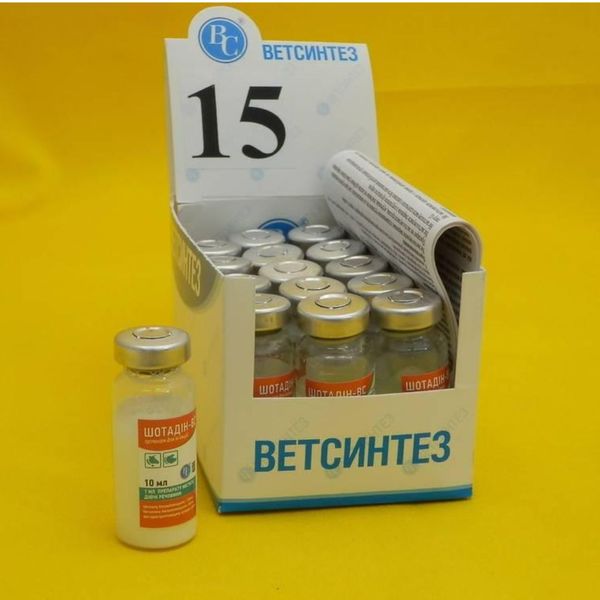|
Quantity
|
Out of stock
|
||
|
|
|||
🐕 SHOTADIN/Combikel 40 L.A. 72 hours🐈
1 ml of the drug contains active substances:
🔹 Benzyl penicillin procaine 100 mg
🔹 Benzathine benzylpenicillin 100 mg
🔹 Dihydrostreptomycin sulfate 200 mg
🚑 INDICATIONS FOR USE
Treatment of dogs and cats with diseases of the gastrointestinal tract (gastroenteritis, dyspepsia and diarrhea of various nature), respiratory organs (bronchitis, pneumonia of various etiologies) and the urogenital system (metritis, mastitis, cystitis), as well as with purulent and secondary infections caused by microorganisms sensitive to the active ingredients of the drug, including Gram-positive bacteria: Clostridium spp., Corynebacterium spp., Erysipelothrix spp., Enterococcus spp., Listeria spp., Staphylococcus spp. (including Staphylococcus aureus), Streptococcus spp.; and Gram-negative microorganisms: Escherichia coli, Salmonella spp., Shigella spp., Klebsiella spp., Pasteurella spp., Brucella spp., Haemophilus spp., Campylobacter spp. and others sensitive to penicillin and dihydrostreptomycin.
🟢 METHOD OF USE AND DOSAGE:
Shake the vial thoroughly before use.
Subcutaneously at a dose of 1 ml per 10 kg of animal body weight once.
In severe cases, it is recommended to re-administer the drug after 3 days.
⚠ CONTRAINDICATIONS
Do not administer to animals with hypersensitivity to penicillins and dihydrostreptomycin.
Do not use the drug in rabbits, guinea pigs, hamsters or other small herbivores.
⚠ Do not administer to animals with impaired renal function.
Do not use concurrently with other beta-lactam antibiotics from the penicillin group type G.
⚠ Do not use concurrently with other antibiotics that have antagonism (gentamicin or kanamycin).
Do not administer intravenously.
🟣 PHARMACOLOGICAL PROPERTIES:
ATC vet classification code QJ01 - antibacterial veterinary drugs for systemic use. QJ01RA01 - Penicillins, combinations with other antimicrobials.
The active substances of the drug are benzyl penicillin procaine and benzyl benzathine penicillin, belonging to beta-lactam antibiotics from the penicillin group, and dihydrostreptomycin sulfate, belonging to antibacterial bactericidal agents from the aminoglycoside group.
Benzyl penicillin procaine has a bactericidal effect, mainly on Gram-positive bacteria. The action of the substance is to inhibit the activity of peptidoglycan synthesis enzymes, which leads to the cessation of bacterial growth, and also activates peptidoglycan hydrolyzing enzymes, which weakens the covalent bonds of the cell wall. Bacterial cells stop dividing, grow, swell and disintegrate with the formation of small particles. The features of procaine benzylpenicillin are slow absorption and prolonged action after administration. Benzathine benzylpenicillin is a beta-lactam antibiotic from the group of penicillins type G with prolonged action. It has a bactericidal effect on sensitive microorganisms by inhibiting the synthesis of cell wall mucopeptides. Active against Gram-positive microorganisms: Staphylococcus spp. (non-penicillinase-forming, Streptococcus spp., including Streptococcus pneumoniae and Streptococcus pyogenes A, Corynebacterium diphtheriae, Erysipelothrix rhusiopathiae, anaerobic spore-forming rods: Bacillus anthracis, Clostridium spp., Actinomys .
Penicillins are very active against Gram-positive microorganisms (Staphylococcus spp., Streptococcus spp., Corynebacterium diphtheriae and others). The mechanism of action is based on the disruption of the synthesis of peptidoglycan mucopeptide, which leads to inhibition of the synthesis of the microorganism's cell wall, inhibition of bacterial growth and reproduction.
Dihydrostreptomycin is an aminoglycoside antibiotic that has a bactericidal effect on Gram-negative and Gram-positive microorganisms (Pasteurella spp., Salmonella spp., E. coli, Klebsiella spp., Hemophilus spp., Brucella spp., Shigella spp., Mycobacterium spp.). The antibacterial effect is based on the binding of the streptomycin molecule to the 30S ribosomal subunit of the microbial cell, which leads to the formation of defective proteins, stopping the growth and development of bacteria. Unlike benzyl penicillin procaine, dihydrostreptomycin sulfate acts on microorganisms that are in both the reproductive and resting phases.
After intramuscular administration, penicillins and dihydrostreptomycin are widely distributed in all tissues of the body. High concentrations are determined in the kidneys, liver, muscles and lungs. When administered parenterally, penicillin is slowly absorbed, so its maximum concentration in serum is observed after 3-4 hours. Dihydrostreptomycin is well absorbed from the injection site. It penetrates well into milk. The maximum concentration of dihydrostreptomycin occurs after 30-90 minutes and remains in the body at a therapeutic concentration for at least 24 hours. Penicillin and dihydrostreptomycin are excreted from the body mainly in urine.
STORAGE:
A dry, dark place at a temperature of 4 ° C to 8 ° C,
out of reach of children and animals, away from food.
BEST BEFORE EXPIRY:
The shelf life of the medicine is 18 months (if stored in a dry, dark place at a temperature of 4°C to 8°C).
The shelf life of the medicine is 12 months (if stored in a dry, dark place at a temperature of 15°C to 25°C).
After first extraction from the vial, the medicine should be used within 28 days if stored in a refrigerator at a temperature of 4°C to 8°C.
































